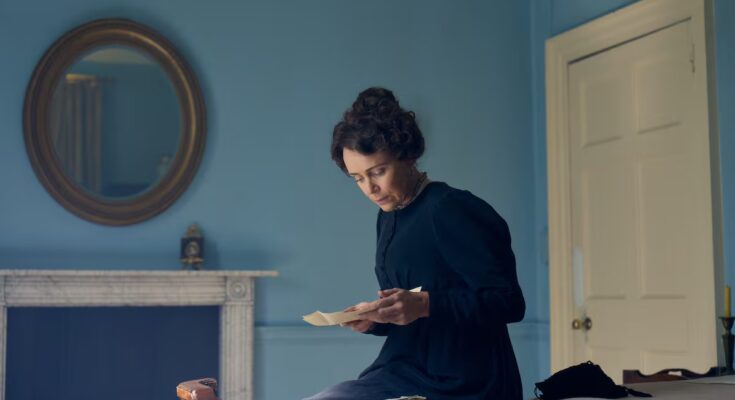Jane Austen (England, 1775-1817) not only wrote successful novels, but also maintained an intense epistolary correspondence with her circle of family and friends. However, of the three thousand letters he signed, only 160 have survived. What happened to the rest? There are clear indications that her sister Cassandra, to whom she was closely linked until her death, made them disappear. What reasons pushed you to destroy them, depriving scholars of such important material? It aims to answer this question Miss Austenthe miniseries created with the participation of the BBC available on Movistar+ in the year in which the 250th anniversary of the writer’s birth is commemorated.
THE Miss Austen of the title is, in this case, Cassandra, who we see, in 1830, determined to search for and recover the letters that her sister sent to Eliza, wife of the Reverend Fowle, in whose house she appears unexpectedly when he is on his deathbed. She’s not the only one interested in obtaining Jane’s correspondence. Even her annoying sister-in-law Mary wants to convince her to incorporate it into her husband’s biography.
The series, of four chapters lasting approximately 50 minutes, directed by the Irish Aisling Walsh, is taken from the novel of the same name by Gill Hornby, who appears as a screenwriter together with its creator, Andrea Gibb, and aims to reconstruct the writer’s life, her joys and frustrations, her periods of meloncholy and his final illness, from his sister’s perspective. The letters found in the Fowle house are the pretext to go back in time in a continuous coming and going between past and present.
Miss Austen It sticks to known historical data about the writer’s life, from changes of residence to the family’s financial difficulties, or Jane’s efforts to get her work published, but also introduces many episodes of pure fiction. As for the reasons that led Cassandra, her loving older sister (they were the only two girls among Reverend Austen’s eight children), to burn her letters, the hypothesis put forward is that she did it to protect Jane’s privacy. The most anonymous would be the only survivors and would end up in Mary’s hands. However, it shows us Cassandra showing signs of irritation while reading some letters. Was your relationship with Jane as perfect and generous as it is presented to us in the series, or were there also elements of friction? The mystery remains.
With a competent cast in which Keeley Hawes plays the mature Cassandra (Synnove Karlsen plays her as a young woman), Patsy Ferran plays a credible Jane, and Jessica Hynes makes up a wonderful Mary, the miniseries stands out for its good setting, and for raising, perhaps inadvertently, the dilemma of who owns the inheritance of famous people, often disputed by their families and biographers, aware of the interest it has for the general public.
Miss Austen It also offers an interesting counterpoint to the serialized version of Pride and prejudice which the BBC made in the nineties and which can also be seen on Movistar+. Curious in this sense are the sequences of Cassandra’s visit to the majestic home of her brother Edward, who in real life married a young aristocrat who in the series is portrayed as a selfish and tense woman, willing to permanently record the social inferiority of her husband’s family. Very far from the model of Mr. Darcy, the eccentric prince charmingFrom Pride and prejudice. Both series can be seen as a game of mirrors between reality and fiction of the world created by Austen, in which the literary superiority of the latter is obviously found.
The characters of the English landed nobility of the late 18th century that the novelist portrayed, such as the imperious Lady Catherine de Bourgh of Pride and prejudice or Mr. Darcy himself, have left an indelible mark that can be traced back to the funny comedies of Oscar Wilde.



